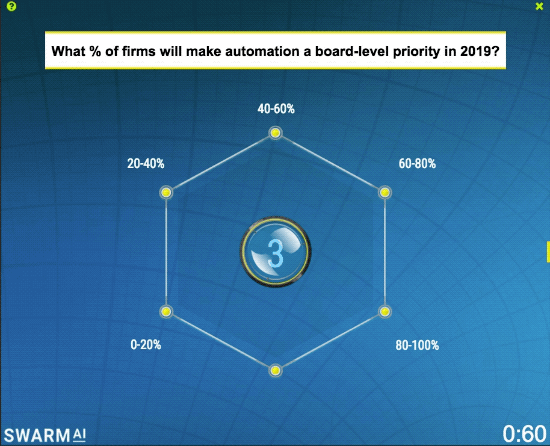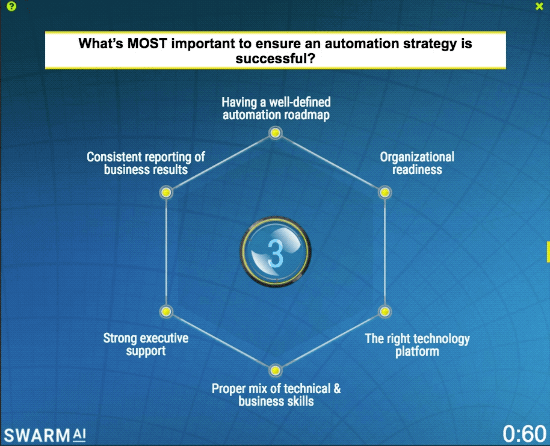Much like other initiatives involving technology, a critical challenge for enterprises that are automating processes is securing organizational support from the top ranks. Executive and board-level support are critical to making sure an enterprise has adequate resources to build, deploy and maintain automations.
At our annual ISG U.S. Automation Summit in Manhattan last month, we revealed early findings from the new ISG Research “Bot 3.0” study, which measures the state of enterprise automation capability in companies in the U.S., Europe, and Australia today. Most attendees are executives and practitioners with responsibility for process automation using robotic process automation (RPA) tools. To measure the collective thinking about where enterprises think the automation market is going, we performed real-time “swarm intelligence” using technology from Unanimous AI. The session enabled attendees to work toward consensus in response to a variety of questions. The responses to two of the questions give us a feel for how board rooms and executive suites are prioritizing automation.
The questions were:
- What percent of firms will make automation a board-level priority in 2019? Answer options were: a) 0-20%, b) 20-40%, c) 40-60%, d) 60-80% and e) 80-100%.
- What’s MOST important to ensure an automation strategy is successful? Answer options were: a) consistent reporting of business results, b) having a well-defined automation roadmap, c) the right technology platform, d) proper mix of technical and business skills, e) organizational readiness, and f) strong executive support.
Regarding how boards of directors are prioritizing process automation, the consensus fell in the 20-40 percent range, converging on about 26 percent. Despite the newness of RPA in the enterprise, those automation leaders in attendance at the Summit think about a quarter of company boards will make automation a board-level priority (Figure 1).
Figure 1: Automation as a Board-level Priority

Source: ISG Research
On the question about which factors is most important to ensuring an automation strategy is successful, the group at the Summit selected strong executive support (Figure 2). While proper mix of technical and business skills was also well-considered, the group showed very little support for consistent reporting of business results or the right technology platform.
Figure 2: Executive Support Most Important

Source: ISG Research
The findings of these two questions mean that, while people involved in enterprise automation think that strong executive support for automation projects is critical to success, many boards have yet to make automation a priority. Executives must understand and support automation initiatives so that they are able to help their boards make automation a higher priority.
ISG research shows that automation using RPA tools is new to many enterprises regardless of industry vertical. In our experience, best practice for most enterprises is to start by automating via proof-of-concept engagements and pilot projects to show potential to the business, begin working on organizational issues and identify key technical hurdles. Automation initiatives need executive sponsorship for the best chance of long-term success, so enterprises should do the demanding work of engaging executives as early as possible and keeping them engaged throughout.
Associated Insights
ISG Automation Summit: Are You Bot 3.0 Ready?
Doing RPA Right – With a Spoonful of External Consultants & Service Providers
RPA in Europe : Enterprise Plans, Budgets & Organizational Impact
Ron’s research agenda is on the cutting edge of location intelligence, the Internet of Things and application modernization with analysis of market trends, provider positioning, deployment challenges and opportunities. With a passion for bridging the gap between business and technology, Ron helps deliver go-to-market strategies for enterprise solution providers in data science, data management, cloud services and analytics. He also works with vendors to develop and execute sales/marketing strategies, competitive analyses, product roadmaps, profit and loss analyses and pricing plans. His integrated systems view means he looks across technologies and business areas to evaluate true market potential and affects. Ron has authored dozens of thought leadership reports for the ISG Insights service.

